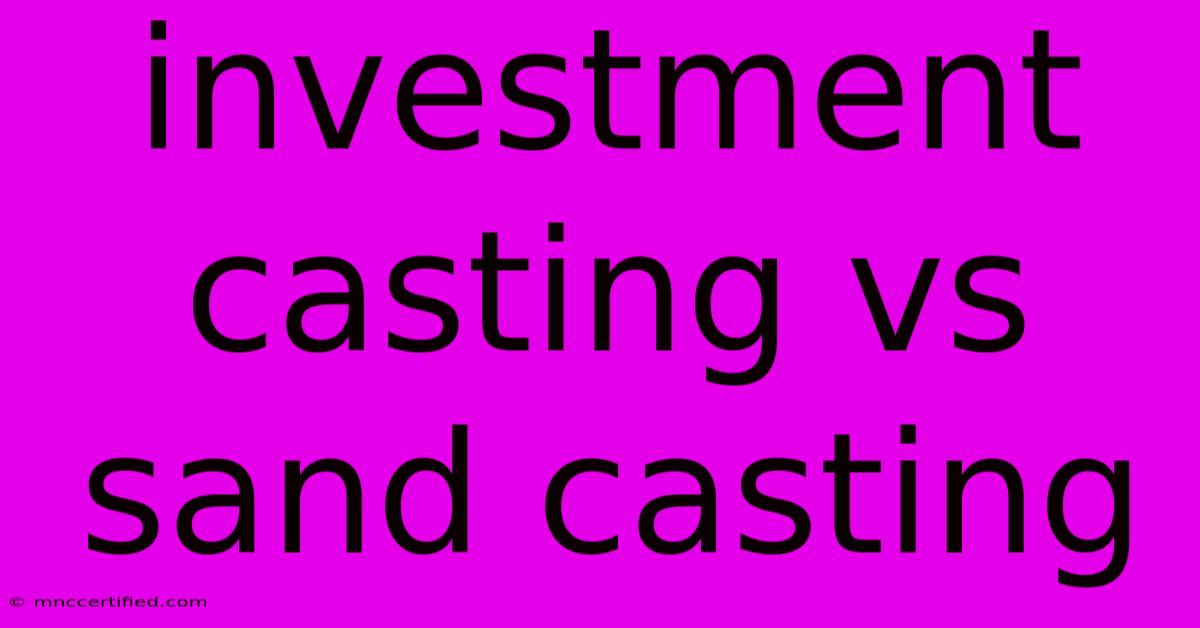Investment Casting Vs Sand Casting

Table of Contents
Investment Casting vs. Sand Casting: Which is Right for Your Project?
Choosing the right casting method is crucial for the success of any project. Two popular options are investment casting (also known as lost-wax casting) and sand casting. While both produce metal parts, they differ significantly in their processes, resulting in variations in cost, precision, and overall quality. This article will delve into the key differences between investment casting and sand casting, helping you make an informed decision for your specific needs.
Understanding Investment Casting (Lost-Wax Casting)
Investment casting is a highly precise method known for its ability to create intricate and complex shapes with exceptional detail. The process involves creating a wax pattern of the desired part, which is then coated in a ceramic shell. The wax is melted out, leaving a cavity that's filled with molten metal. Once cooled, the ceramic shell is broken away, revealing the finished casting.
Advantages of Investment Casting:
- High Precision and Accuracy: Investment casting delivers exceptional dimensional accuracy and surface finish, making it ideal for parts requiring tight tolerances.
- Intricate Designs: Its ability to create complex geometries, including undercuts and thin walls, surpasses sand casting.
- Excellent Surface Finish: The process results in a smooth surface finish, often requiring minimal machining.
- Wide Range of Metals: Various metals, including steel, aluminum, brass, and precious metals, can be cast using this method.
Disadvantages of Investment Casting:
- Higher Cost: Investment casting is generally more expensive than sand casting due to the more complex and labor-intensive process.
- Longer Lead Times: The multiple stages involved contribute to longer production times compared to sand casting.
- Smaller Batch Sizes: While capable of larger runs, investment casting is often more economically viable for smaller to medium batch sizes.
- Limited Wall Thickness: While capable of thin walls, there are limitations compared to sand casting, depending on the metal used.
Understanding Sand Casting
Sand casting is a time-tested, cost-effective method for producing metal parts in large quantities. A mold is created using sand, a pattern (often made of wood or metal), and a binding agent. Molten metal is poured into the mold, allowed to cool, and then the sand is removed, revealing the casting.
Advantages of Sand Casting:
- Low Cost: Sand casting is significantly less expensive than investment casting due to its simpler process and readily available materials.
- High Production Rates: It's well-suited for mass production, allowing for large quantities of castings to be produced efficiently.
- Large Part Sizes: Sand casting can accommodate the production of much larger parts than investment casting.
- Versatility in Metal Selection: Like investment casting, it supports a broad range of metal alloys.
Disadvantages of Sand Casting:
- Lower Precision: Sand castings generally have lower dimensional accuracy and surface finish compared to investment castings. More machining may be required.
- Limited Complexity: Creating intricate designs with undercuts or thin walls is challenging and may not be feasible.
- Rougher Surface Finish: Sand castings typically have a rougher surface finish, demanding further surface treatment.
- Higher Scrap Rate: The potential for defects is higher, leading to a higher percentage of unusable castings.
Investment Casting vs. Sand Casting: A Comparison Table
| Feature | Investment Casting | Sand Casting |
|---|---|---|
| Cost | High | Low |
| Precision | High | Low |
| Complexity | High (Intricate designs possible) | Low (Limited complexity) |
| Surface Finish | Excellent | Rough |
| Production Rate | Lower | High |
| Lead Time | Longer | Shorter |
| Part Size | Smaller to medium | Large |
| Best For | High-precision parts, intricate designs | Mass production, large parts, lower cost |
Choosing the Right Method
The optimal casting method depends entirely on your project's specific requirements. Consider these factors:
- Part Geometry: For complex shapes, investment casting is preferred. For simpler designs, sand casting is suitable.
- Required Precision: If high accuracy and tight tolerances are necessary, investment casting is the better choice.
- Production Volume: For mass production, sand casting's cost-effectiveness shines.
- Budget: Sand casting offers a lower initial investment.
- Lead Time Constraints: Sand casting generally offers faster turnaround times.
By carefully weighing these factors, you can select the casting method that best aligns with your project goals and ensures the production of high-quality, cost-effective metal components. Remember to consult with experienced casting professionals for personalized guidance.

Thank you for visiting our website wich cover about Investment Casting Vs Sand Casting. We hope the information provided has been useful to you. Feel free to contact us if you have any questions or need further assistance. See you next time and dont miss to bookmark.
Featured Posts
-
Renters Insurance Rancho Cucamonga
Nov 17, 2024
-
Lillard Middleton Injury Bucks Game Preview
Nov 17, 2024
-
Do You Need Boat Insurance In Ohio
Nov 17, 2024
-
Staffing Agency Insurance Coverage
Nov 17, 2024
-
Colorado Vs Utah Football Tickets Sold Out
Nov 17, 2024